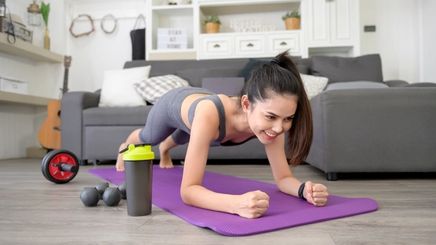
Many of us associate an ab workout with sit-ups. Once considered the benchmark for developing abdominal strength, this popular core exercise has gained notoriety in recent years for causing back pain and damaging lumbar discs. In 2015, the U.S. Army even phased it out from their fitness program.
Sit-ups—as well as crunches—put a dangerous amount of pressure on the base of your curved spine and hip flexors. While sitting up the way we would when getting up from a laid-down position is okay, doing the movement repetitively can wear out your lumbar discs. Moreover, both exercises work the muscles from the thighs to the lower vertebrae. Isolating the muscles in this area and making them too tight can cause lower back discomfort.
Fortunately, there are many other alternatives to developing your ab and core strength that are easy on the back and easy for anyone to do.
The Static Plank
Considered the new gold standard for ab work, planking is popular because it requires . Depending on where you are fitness-wise, you can adjust your position to varying levels of difficulty.
The knee plank is the easiest variation. From a prone position, lift your upper body with your arms. Your hands must be parallel to your shoulders, and your knees and toes must be touching the ground. Use a mat or towel to soften the pressure on your knees. Your neck should be aligned with your back.
The standard plank, on the other hand, starts the same way, but you lift your knees, so only your toes and palms are touching the floor. Make sure that your entire body is stiff and straight and your hips are not bent. Hold the pose for 20 seconds.
More difficult versions include pushing your body up using your forearms and balancing each side using either a hand or leg. As with most static exercises, form is important to prevent injury. Try out different plank variations to find out which one you’re most comfortable with without compromising your form. As you get stronger, you can lengthen the duration and progress to more challenging styles.
The Glute Bridge
You don’t have to be flexible to do this type of bridge. Lay down on your back with your knees bent and your feet flat on the ground. Keep your arms parallel to your body, palms down. Then, raise your hips off the ground just until your back is straight (don’t overstretch). Keeping your core tight and engaged, hold this position for 30 seconds in three sets. Not only is this a great ab workout, but it also develops your hamstrings.
This exercise is also ideal for post-partum women experiencing diastasis recti (muscle separation in the stomach area) who have been given the go-signal by their doctors to exercise.
Leg Raises
Lay down on a mat with your legs straight and together. In its most basic version, keep your arms straight on your sides, palms down. Slowly lift both legs together until they’re about one foot off the ground. A common cheat to this exercise is to swing the legs up fast. However, make sure to clench your abs and keep your legs straight as you raise them slowly. Hold this position for at least 30 seconds. Accomplish in three sets.
When you’re ready for a bigger challenge, you can cross your arms over your chest. Or, even more difficult, lift your legs to a full 90-degree angle. Instead of sticking with this position for a certain period, slowly lower your legs back down—still straight until your feet are just an inch off the ground. Repeat 10 to 15 times in three sets.
Mountain Climbers
Start in a push-up position. Your hands must be a little wider than your chest and turned slightly away from your body to lighten the burden on your shoulders. Make sure your back and neck are straight and aligned. As you hold this position, bend your right knee up to your chest. Do the same with your left knee. Do this alternately for a set time (30 seconds would be a good starting point), depending on your fitness level.
Make sure to watch your back! For this ab workout to be effective, your spine shouldn’t curve or bend.
The Dead Bug
Lay down on a mat with your arms extended towards the sky and your legs lifted, both knees bent at a 90-degree angle, feet flexed, and toes are pointing upward. As you drop your stretched right arm to the top of your head, extend your left knee while keeping the rest of your body locked in the starting position. Now do it the other way—with your left arm and your right knee. Remember to keep your muscles tense and active. Do this alternately for 30 seconds, increasing the length of time or even the number of reps as you improve.
Whichever ab workout you choose will have you working up a sweat. Make sure you have a that can keep up with your active lifestyle, like Rexona Women Shower Clean Antiperspirant Deodorant. It's not an unscented antiperspirant, but it will leave you feeling like you got out of the shower before, during, and after exercise. It uses MotionSense technology that will help you smell better the more you move.
When you’re actually ready to hit the shower, reward your tired muscles with Dove Care & Protect. This powerful but gentle body wash has Dove's signature 1/4 moisturizing cream as well as Anti-Bac technology, eliminating 99% of germs while keeping your skin nourished. Treat your hair with the same kindness. Love Beauty and Planet Radical Refresher Shampoo has tea tree oil that cleanses the hair, removing all sorts of exercise-related debris while volumizing it to help your lock look as vibrant and strong as you are.
So, sit up and pay attention. You don’t have to let back problems deter you from accomplishing an ab workout. Just follow these low-impact, back-friendly exercises, and you’ll have a stronger core in time.